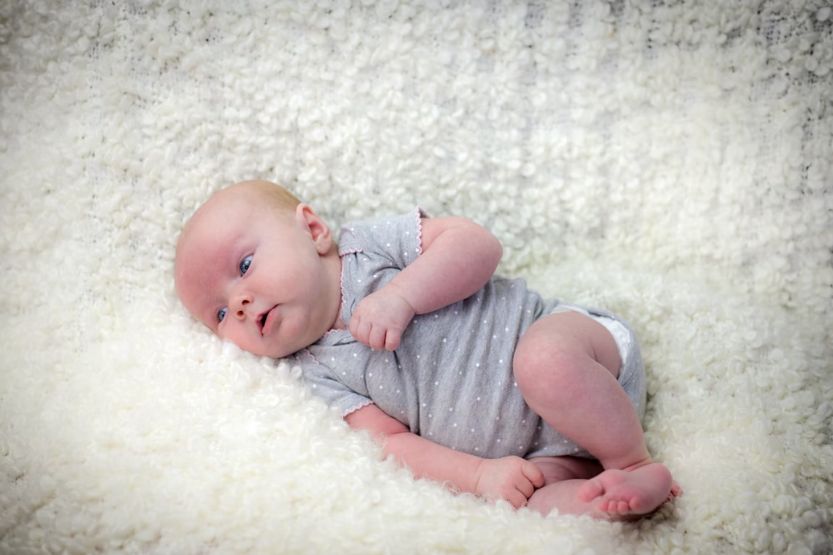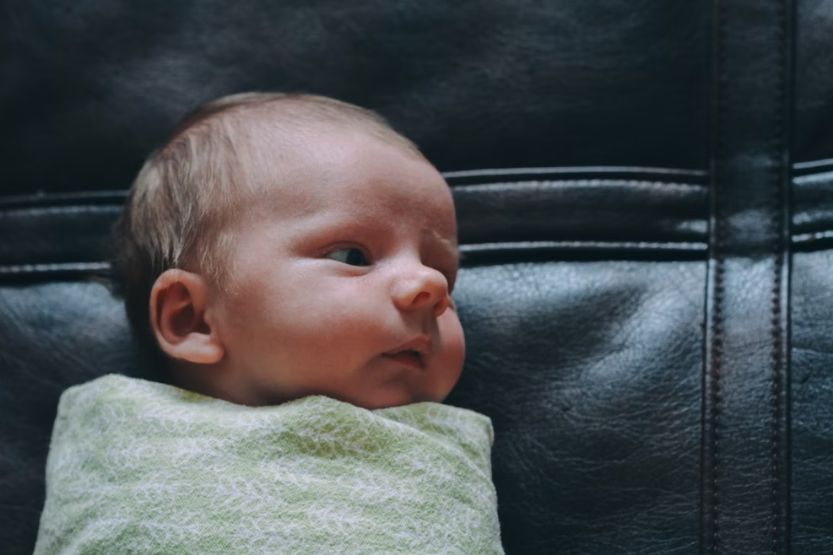Many parents are worried when they see their newborn baby rolling to the side while sleeping. This can happen with or without swaddles and is something that you should be aware of when your child is sleeping. Fortunately, this doesn’t typically cause any health issues. But what should you do? Is this something that frequently happens with newborns? Should you be worried?
Newborns have an instinct to roll to the side while sleeping. Rolling over is one of the first developmental milestones for newborns. It’s when they start learning how to move around on their own. However, babies from birth to 12 months must be put to sleep on their backs and not their sides or stomach to lessen the risk of sudden infant death syndrome or SIDS.
Read on to know why newborns roll to their side while sleeping and what you can do about it.
When Does a Newborn Roll Over?

Typically Happens Around 4 or 5 Weeks
Newborns who roll over do so at about two weeks, though some may start rolling sooner and others later. Rolling to the side is a common milestone, but rolling to their backs is a more advanced skill that typically happens around 4 or 5 weeks.
For most newborns, it’s okay for them to roll onto their sides, but not until around six months old should you allow them to sleep on their tummies or backs.
Can Get Stuck in Difficult Positions
When babies start rolling over, they can get stuck in difficult positions. This can lead to suffocation if something blocks their airways or causes them to be unable to breathe well due to being in an awkward position with no means of getting out of it on their own.
If this happens when your baby sleeps horizontally (like on his back), they won’t be able to breathe properly enough through their mouth.
Their tongue blocks part of it off when pressure is exerted against its surface. This results in less oxygen getting into their lungs, which could potentially cause death if left untreated long enough. So always observe babies while they nap.
Why Does the Baby Roll Over?
It is due to a reflex that babies are born with. This reflex helps protect your baby from suffocation or smothering if they were to sleep belly-down on a mattress or pillow.
It’s also why you may notice your newborn rolling from their back to their stomach and back again throughout the day. It is their body’s way of helping them breathe better since they still cannot move their head freely on their own.
The explanation is pretty simple: when we lie down, our bodies relax, and gravity does its job. This means it’ll cause us to fall in whichever direction gravity pulls us. In most cases, this would be straight down.
Without any support underneath your newborn other than a blanket or clothing you’ve wrapped around them at night, it makes sense why even babies would instinctively roll over onto their sides after falling asleep, especially when they’re used to sleeping on soft mattresses.
Is It Okay for a Newborn to Sleep on the Side?
Not Always Safe to Let Them Sleep on Their Sides
No, newborns are not always safe to sleep on their sides. You should put your baby to sleep on their back from birth and continue to do so until they are one year old. While the risk of SIDS is highest in the first six months, sleeping on the back is recommended for the entire 1st year of your child.
Can Lead to Rebreathing
Side sleeping can lead to “rebreathing,” which occurs when a newborn breathes in their exhaled air, lowering their oxygen levels and raising their carbon dioxide levels.
If your newborn is sleeping on a soft mattress or with pillows, blankets, or stuffed animals near their face, they are even more likely to rebreathe.
More Difficult to Expel Excess Heat
Newborns sleeping on their side or stomach can make it more difficult for their bodies to expel excess heat. This could lead to overheating, another factor that raises the risk of SIDS.
But there’s no need to worry. Make sure you put them on their back in an approved crib or bassinet with a firm mattress. You don’t want your newborn rolling to the side in the bassinet, potentially suffocating themselves.
When Can Your Baby Sleep Safely on Their Side?
When your baby is older than 4 to 6 months and can roll over independently after being placed on their back, side sleeping is usually safe. However, it’s still best to lie your baby on their back for naps and bedtime.
Putting your baby to bed on their stomach isn’t a good idea during the first year of life. And putting them in a side-sleeping position is easy to get to the stomach. Tummy time is always the best option when your baby is awake and ready to play with you.
Newborn Side Sleeping Prevents Choking – True or False?
It’s false. The concept that side sleeping prevents newborns from choking on their spit-up, also known as reflux, is a myth. In fact, according to the National Institute of Child Health and Human Development, no evidence correlates reflux and babies sleeping on their backs.
Even while asleep, babies have natural reflexes that cause them to cough up or swallow any spit-up. Have you noticed how easily your baby burps up spit-up? They can naturally do this also in their sleep.
But it’s important to note that you shouldn’t ignore your baby’s reflux. If your newborn is crying during feeding time or spitting up often and consistently, seek medical advice from your pediatrician immediately.
Newborn Rolling to the Side and Cannot Come Back

Parents and caregivers may be concerned that their newborns will become suffocated if they begin to roll, whether awake or asleep.
But when an infant rolls onto their stomach, they have sufficient head control to elevate their head and breathe. It’s also easier for them to roll from their stomach to their back. So if infants can roll onto their stomachs, know they can roll back.
Because of this, once your baby can roll over, there is no need to roll them back. When babies can discover a comfortable sleeping position on their own, they sleep the best and are the safest.
It is, however, important to ensure that their cot has been safety checked and does not have any coverings that could trap their head.
Newborn Waking Up After Rolling to the Side
Some newborns wake up when they roll over. They may get excited about this new skill that they constantly roll around in bed.
And when your baby learns new skills, their sleeping habits are likely to shift. Most newborns eventually learn to calm down, sometimes on their own or with the assistance of a parent or caregiver.
This could include shifting the baby to a crib and removing swaddling from the routine. Retaining as much of the old routine as possible, on the other hand, may help the baby adjust to their newfound independence.
The following tips can help improve your newborn’s sleep quality:
- Put your baby in a cold, dark, and quiet room;
- Use a white noise machine or gently shush the baby back to sleep;
- Establish a consistent nighttime routine; and
- Set a regular bedtime each night.
Newborn Rolling to the Side in the Swaddle
Have you ever noticed that your baby seems to roll to one side in the swaddle? Don’t worry; it’s not uncommon. It’s pretty common for babies to roll to the left or right in their swaddle.
Newborns and infants tend to roll to one side while they sleep. This is normal, and it can happen whether you swaddle them or not.
When your baby has been swaddled for a while, it may start to move around. Plus, kick out of the blankets. And as they age, they often move around more during sleep cycles. So you mustn’t keep them in a swaddle for too long at once.
If you think your baby may have rolled over entirely while sleeping in the swaddle, try taking off one arm first and then slowly taking off the rest.
This way, they can get used to being free from the fabric while still being wrapped up safely. It’s also another way to help prevent sudden infant death syndrome or SIDS.
Again, why does my newborn keep rolling on his side? Most newborns start to roll over when they are 4 to 6 months. You do not have to turn them over on their back when they roll over while asleep.
Newborn Curl vs. Rolling
The newborn curl is a common position for newborns. It’s when they’re curled up on their side, with their knees tucked in and their arms curled around them. On the other hand, newborn rolling is when they move from the curl position to being entirely on their stomachs.
Newborns will often stay in the curl pose for a long time, sometimes as long as an hour or more. Why? The reason is that it’s easier for them to breathe this way, and it feels safer for them.
While no studies prove this theory, many parents believe that babies prefer this position because it reminds them of being inside the womb. Most infants will lose this ability within the first month.
How to Keep Newborns From Rolling Over While Sleeping

1. Keep Your Newborn on Their Back
The safest sleep position for newborns is always to keep them on their backs. This decreases the risk of sudden infant death syndrome (SIDS) and suffocation and helps prevent hip dysplasia and flat head syndrome later in life.
2. Use a Swaddle
Swaddling is an easy way to keep your newborn still during naps. It can be helpful while they’re getting used to sleeping without moving too much in their cribs, bassinets, or co-sleepers. Wrapping your newborn in a swaddle makes it easier for them to sleep on their back comfortably.
When they are wrapped up tightly and their movements are restricted, their ability to roll over is limited. This makes them more likely to stay on their back during sleep.
However, it’s important to know when to stop swaddling as it can also become risky when your little one is capable of rolling frequently.
3. Consider Using a Sleep Sack
Try a sleep sack if your newborn can’t take being swaddled. It’s also a nice transitional step. A sleep sack is a small sleeping sack that your baby sleeps in. Arms-free versions are safer for rolling newborns, but the sack itself may help your newborn sleep longer without rolling over onto their side.
4. Ensure That the Mattress or Bassinet Surface Is Firm
Make sure the mattress has no soft spots where your baby could get stuck in between. Place your newborn on a firm mattress or bassinet surface so they don’t roll over during nap time.
It’s important that they only sleep on their back at this stage. It is one of the best ways young ones won’t roll over accidentally as it keeps them safe from potential hazards like pillows and blankets.
5. Keep Your Newborn Close By
Keeping your baby close is a great strategy to monitor them and prevent them from rolling over while sleeping. A cot beside your bed is the safest place for your newborn to sleep. This means you can see your baby right away when they roll to their side.
Frequently Asked Questions – Sleeping Newborn Rolling to the Side
Why Does My Newborn Keeps Rolling on Their Side to Sleep?
Newborns may feel excited about the new skill they learned that they roll around in bed all the time. When infants learn new skills, their sleeping habits are likely to shift. Most newborns eventually learn to calm down, sometimes with the assistance of a parent or caregiver and sometimes on their own.
Can a 2-Week-Old Sleep on Their Side?
Until your child is at least one year old, you should always lay them down to sleep on their back. It’s fine to leave your baby on their tummy if they roll that way, but only until they can roll from tummy to back on their own.
Why Do Babies Roll Around While Sleeping?
When it comes to why it happens during naps and nighttime, it’s usually the same reason adults shift positions when sleeping: to get more comfortable. And even after your baby has fallen asleep, they may roll around and wake up because they are uncomfortable.
Is Side-Lying Position Safe for Newborn?
It can be dangerous if a mother falls asleep while laid-back breastfeeding or side-lying. Also, it can be hazardous if a baby falls or is smothered by bedding, clothing, or the mother’s body.
Should I Stop Swaddling When Baby Rolls to Side?
When your baby begins to roll over, stop swaddling them. It usually takes between 2 and 4 months. During this period, your baby may be able to turn onto their stomach but not back over. This could put them at risk of SIDS.
What Sleeping Positions Cause SIDS?
According to studies, the side sleep position is unstable and raises the risk of newborns rolling onto their stomachs — such sleep position is linked to the highest risk of SIDS. The American Academy of Pediatrics Task Force recommends that newborns sleep on their backs for naps and at night.
Conclusion – Newborn Babies Roll to the Side While Sleeping
When babies roll over, they get closer to crawling, sitting, and eventually walking. It is a significant developmental milestone, allowing them to reach their desired objects and establish more control over their environment.
Rolling to the side while sleeping can be a great way for newborns to sleep more comfortably. But it’s important to be aware of any potential risks or complications from this behavior.
You can follow the guidelines discussed above to prevent any problems with newborns rolling over to the side while sleeping.
Talk with your pediatrician if you have any other concerns about your newborn’s rolling habits or health.



